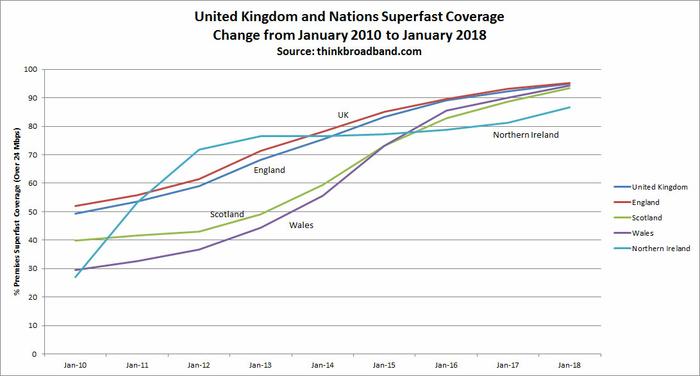The UK has passed a significant Superfast Broadband coverage milestone. Across the nation more than 95 per cent of premises (residential and business) now have access to Superfast Broadband offering 24Mbps download or faster speeds. A report on the news, published by Think Broadband, puts the exact figure at 95.0079 per cent.
The 95 per cent figure isn’t a consistent representation of the broadband speeds in every area of the UK. Some regions such as Epson and Ewell, Tamworth, Worthing and Watford have nearly 99 per cent coverage. Meanwhile, at the sorry end of the table, there are regions that include The City of London (50.3 per cent), the Orkney Islands (66.8 per cent) and Hull (71.7 per cent). You can check the latest rank, coverage, and speeds data for the 650 UK constituencies here.
click to zoom chart
If you look at the 95 per cent milestone (and that more than 19 out of 20 UK homes and businesses can now get >24Mbps speeds), and worry that you are still in the internet connection dark ages, the Department for Digital, Culture, Media & Sport (DCMS) has some reassurance to offer. DCMS Secretary of State, Matt Hancock made the following statement:
“Over the last 5 years, the Government’s rollout of superfast broadband has made superfast speeds a reality for more than 4.5 million homes and businesses who would otherwise have missed out. We’ve delivered on our commitment to reach 95 per cent of homes and businesses in the UK, but there’s still more to do in our work building a Britain that’s fit for the future. We’re reaching thousands more premises every single week, and the next commitment is to making affordable, reliable, high speed broadband a legal right to everyone by 2020.”
The above mentioned legal right stems from the Universal Service Obligation, a promise of high speed broadband (10Mbps or faster) for everyone by 2020. Meanwhile more and more people should get superfast broadband as fibre and similar super fast connectivity continues to roll out. Remember, there are more targets to be met ahead of us; the government aim to achieve 97 – 98 per cent superfast broadband coverage sometime in 2019, for example.














